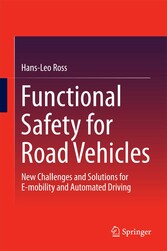Suchen und Finden
Mehr zum Inhalt

Functional Safety for Road Vehicles - New Challenges and Solutions for E-mobility and Automated Driving
Foreword of the Author
5
Preface
6
Acknowledgments
9
Contents
10
1 Introduction
13
1.1 Definitions and Translations from the ISO 26262
14
1.2 Error Terms of the ISO 26262
17
References
18
2 Why Functional Safety in Road Vehicles?
19
2.1 Risk, Safety and Functional Safety in Automobiles
19
2.2 Quality Management System
25
2.2.1 Quality Management Systems from the Viewpoint of ISO 26262
29
2.3 Advanced Quality Planning
30
2.4 Process Models
32
2.4.1 V-Models
33
2.4.2 Waterfall Model
42
2.4.3 Spiral Model
43
2.5 Automotive and Safety Lifecycles
45
2.5.1 Safety Lifecycles for the Development of Automotive Products
47
2.5.2 Safety-Lifecycles According to ISO 26262
48
2.5.3 Security-Versus Safety Lifecycles
50
References
50
3 System Engineering
52
3.1 Historic and Philosophic Background
52
3.2 Reliability Engineering
54
3.2.1 Foundation/Basis of Reliability
56
3.2.2 Reliability and Safety
60
3.3 Architecture Development
62
3.3.1 Stakeholder of Architectures
64
3.3.2 Views of Architecture
67
3.3.3 Horizontal Level of Abstraction
69
3.4 Requirements and Architecture Development
77
3.5 Requirements and Design Specification
79
References
85
4 System Engineering for Development of Requirements and Architecture
86
4.1 Function Analysis
89
4.2 Hazard and Risk Analysis
91
4.2.1 Hazard Analysis and Risk Assessment according to ISO 26262
92
4.2.2 Safety Goals
101
4.3 Safety Concepts
104
4.3.1 The Functional Safety Concept
107
4.3.2 Technical Safety Concept
117
4.3.3 Microcontroller Safety Concept
121
4.4 System Analyses
125
4.4.1 Methods for the System Analysis
126
4.4.2 Safety Analysis According to ISO 26262
130
4.4.2.1 Failure/Error Propagation
137
4.4.2.2 Error Propagation in the Horizontal and in the Vertical
142
4.4.2.3 Inductive Safety Analysis
147
4.4.2.4 Deductive Safety Analysis
150
4.4.2.5 Quantitative Safety Analysis
156
4.4.2.6 Architecture Metrics
160
4.4.2.7 Top Failure Metrics (Probabilistic Metric for Random Hardware Failure, PMHF)
166
4.4.2.8 Failure Metrics for Sensors or other Components
172
4.4.2.9 Analysis of Dependent Failures (ADF)
174
4.4.2.10 Safety Analysis in the Safety Lifecycle
181
4.4.3 Safety and Security Error Propagation
188
4.5 Verification During Development
188
4.6 Product Development at System Level
190
4.7 Product Development at Component Level
194
4.7.1 Mechanical Development
197
4.7.2 Electronic Development
198
4.7.3 Software Development
203
References
210
5 System Engineering in the Product Development
211
5.1 Product Realization
211
5.1.1 Product Design for Development
212
5.1.2 Mechanics
212
5.1.3 Electronics
214
5.1.4 Software
214
5.2 Functional Safety and Timing Constraints
216
5.2.1 Safety Aspects of Fault-Reaction-Time-Interval
216
5.2.2 Safety Aspects and Real-Time Systems
217
5.2.3 Timing and Determinism
219
5.2.4 Scheduling Aspects in Relation to Control-Flow and Data-Flow Monitoring
221
5.2.5 Safe Processing Environment
224
6 System Integration
226
6.1 Verifications and Tests
227
6.1.1 Basic Principles for Verifications and Tests
234
6.1.2 Verification based on Safety Analyses
237
6.1.3 Verification of Diverse Objectives such as Safety and Security
241
6.1.4 Test Methods
242
6.1.5 Integration of Technical Elements
243
6.2 Safety Validation
245
6.3 Model Based Development
248
6.3.1 Models for Functional Safety
250
6.3.2 Foundation for Models
253
6.3.3 Model Based Safety Analysis
254
6.4 Approvals/Releases
255
6.4.1 Process Releases
256
6.4.2 Release for Series Production
257
6.4.3 Production Part Approval Process (PPAP)
258
References
260
7 Confirmation of Functional Safety
261
7.1 Confirmation Reviews
265
7.2 Functional Safety Audits
269
7.3 Assessment of Functional Safety
270
7.4 Safety Case
271
References
273
Index
274
Alle Preise verstehen sich inklusive der gesetzlichen MwSt.







